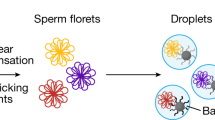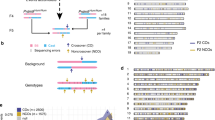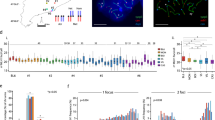Abstract
PRDM9 has recently been identified as a likely trans regulator of meiotic recombination hot spots in humans and mice1,2,3. PRDM9 contains a zinc finger array that, in humans, can recognize a short sequence motif associated with hot spots4, with binding to this motif possibly triggering hot-spot activity via chromatin remodeling5. We now report that human genetic variation at the PRDM9 locus has a strong effect on sperm hot-spot activity, even at hot spots lacking the sequence motif. Subtle changes within the zinc finger array can create hot-spot nonactivating or enhancing variants and can even trigger the appearance of a new hot spot, suggesting that PRDM9 is a major global regulator of hot spots in humans. Variation at the PRDM9 locus also influences aspects of genome instability—specifically, a megabase-scale rearrangement underlying two genomic disorders6 as well as minisatellite instability7—implicating PRDM9 as a risk factor for some pathological genome rearrangements.
This is a preview of subscription content, access via your institution
Access options
Subscribe to this journal
Receive 12 print issues and online access
$209.00 per year
only $17.42 per issue
Buy this article
- Purchase on Springer Link
- Instant access to full article PDF
Prices may be subject to local taxes which are calculated during checkout






Similar content being viewed by others
References
Baudat, F. et al. PRDM9 is a major determinant of meiotic recombination hotspots in humans and mice. Science 327, 836–840 (2010).
Myers, S. et al. Drive against hotspot motifs in primates implicates the PRDM9 gene in meiotic recombination. Science 327, 876–879 (2010).
Parvanov, E.D., Petkov, P.M. & Paigen, K. Prdm9 controls activation of mammalian recombination hotspots. Science 327, 835 (2010).
Myers, S., Freeman, C., Auton, A., Donnelly, P. & McVean, G. A common sequence motif associated with recombination hot spots and genome instability in humans. Nat. Genet. 40, 1124–1129 (2008).
Paigen, K. & Petkov, P. Mammalian recombination hot spots: properties, control and evolution. Nat. Rev. Genet. 11, 221–233 (2010).
Turner, D.J. et al. Germline rates of de novo meiotic deletions and duplications causing several genomic disorders. Nat. Genet. 40, 90–95 (2008).
Jeffreys, A.J. et al. Complex gene conversion events in germline mutation at human minisatellites. Nat. Genet. 6, 136–145 (1994).
Hayashi, K., Yoshida, K. & Matsui, Y. A histone H3 methyltransferase controls epigenetic events required for meiotic prophase. Nature 438, 374–378 (2005).
The International HapMap Consortium. A second generation human haplotype map of over 3.1 million SNPs. Nature 449, 851–861 (2007).
Webb, A.J., Berg, I.L. & Jeffreys, A. Sperm cross-over activity in regions of the human genome showing extreme breakdown of marker association. Proc. Natl. Acad. Sci. USA 105, 10471–10476 (2008).
Jeffreys, A.J. & Neumann, R. The rise and fall of a human recombination hot spot. Nat. Genet. 41, 625–629 (2009).
Jeffreys, A.J., Ritchie, A. & Neumann, R. High resolution analysis of haplotype diversity and meiotic crossover in the human TAP2 recombination hotspot. Hum. Mol. Genet. 9, 725–733 (2000).
Jeffreys, A.J. & Neumann, R. Reciprocal crossover asymmetry and meiotic drive in a human recombination hot spot. Nat. Genet. 31, 267–271 (2002).
Jeffreys, A.J. & Neumann, R. Factors influencing recombination frequency and distribution in a human meiotic crossover hotspot. Hum. Mol. Genet. 14, 2277–2287 (2005).
Wolfe, S.A., Nekludova, L. & Pabo, C.O. DNA recognition by Cys2His2 zinc finger proteins. Annu. Rev. Biophys. Biomol. Struct. 29, 183–212 (2000).
Neumann, R. & Jeffreys, A.J. Polymorphism in the activity of human crossover hotspots independent of local DNA sequence variation. Hum. Mol. Genet. 15, 1401–1411 (2006).
Buard, J., Bourdet, A., Yardley, J., Dubrova, Y. & Jeffreys, A.J. Influences of array size and homogeneity on minisatellite mutation. EMBO J. 17, 3495–3502 (1998).
Tamaki, K., May, C.A., Dubrova, Y.E. & Jeffreys, A.J. Extremely complex repeat shuffling during germline mutation at human minisatellite B6.7. Hum. Mol. Genet. 8, 879–888 (1999).
Berg, I., Neumann, R., Cederberg, H., Rannug, U. & Jeffreys, A.J. Two modes of germline instability at human minisatellite MS1 (locus D1S7): complex rearrangements and paradoxical hyperdeletion. Am. J. Hum. Genet. 72, 1436–1447 (2003).
Jeffreys, A.J., Murray, J. & Neumann, R. High-resolution mapping of crossovers in human sperm defines a minisatellite-associated recombination hotspot. Mol. Cell 2, 267–273 (1998).
Conrad, D.F. et al. Origins and functional impact of copy number variation in the human genome. Nature 464, 704–712 (2010).
Pentao, L., Wise, C.A., Chinault, A.C., Patel, P.I. & Lupski, J.R. Charcot-Marie-Tooth type 1A duplication appears to arise from recombination at repeat sequences flanking the 1.5 Mb monomer unit. Nat. Genet. 2, 292–300 (1992).
Lindsay, S.J., Khajavi, M., Lupski, J.R. & Hurles, M.E. A chromosomal rearrangement hotspot can be identified from population genetic variation and is coincident with a hotspot for allelic recombination. Am. J. Hum. Genet. 79, 890–902 (2006).
Kurahashi, H. & Emanuel, B.S. Unexpectedly high rate of de novo constitutional t(11;22) translocations in sperm from normal males. Nat. Genet. 29, 139–140 (2001).
Kato, T. et al. Genetic variation affects de novo translocation frequency. Science 311, 971 (2006).
Reich, D.E. et al. Linkage disequilibrium in the human genome. Nature 411, 199–204 (2001).
Kong, A. et al. Sequence variants in the RNF212 gene associate with genome-wide recombination rate. Science 319, 1398–1401 (2008).
Chowdhury, R. et al. Genetic analysis of variation in human meiotic recombination. PLoS Genet. 5, e1000648 (2009).
Kurahashi, H. et al. Tightly clustered 11q23 and 22q11 breakpoints permit PCR-based detection of the recurrent constitutional t(11;22). Am. J. Hum. Genet. 67, 763–768 (2000).
Monckton, D.G. et al. Minisatellite mutation rate variation associated with a flanking DNA sequence polymorphism. Nat. Genet. 8, 162–170 (1994).
Acknowledgements
We thank J. Blower and volunteers for providing semen samples, colleagues for helpful discussions and the Medical Research Council, the Wellcome Trust (ref. 081227/Z/06/Z), the Boehringer Ingelheim Fonds, the Royal Society and the Louis-Jeantet Foundation for funding support.
Author information
Authors and Affiliations
Contributions
I.L.B., R.N., K.-W.G.L., S.S., L.O.-H., C.A.M. and A.J.J. all contributed to designing aspects of the study. I.L.B., R.N. and A.J.J. characterized PRDM9 alleles, I.L.B., S.S., L.O.-H. and A.J.J. analyzed hot spots, R.N. surveyed minisatellite instability, K.-W.G.L. characterized genome rearrangements and A.J.J. analyzed translocations. A.J.J. wrote the paper.
Corresponding author
Ethics declarations
Competing interests
The authors declare no competing financial interests.
Supplementary information
Supplementary Text and Figures
Supplementary Tables 1–3 and Supplementary Figures 1 and 2 (PDF 711 kb)
Rights and permissions
About this article
Cite this article
Berg, I., Neumann, R., Lam, KW. et al. PRDM9 variation strongly influences recombination hot-spot activity and meiotic instability in humans. Nat Genet 42, 859–863 (2010). https://doi.org/10.1038/ng.658
Received:
Accepted:
Published:
Issue Date:
DOI: https://doi.org/10.1038/ng.658
This article is cited by
-
Genome-wide recombination map construction from single sperm sequencing in cattle
BMC Genomics (2022)
-
Evolution of the recombination regulator PRDM9 in minke whales
BMC Genomics (2022)
-
Sequencing individual genomes with recurrent genomic disorder deletions: an approach to characterize genes for autosomal recessive rare disease traits
Genome Medicine (2022)
-
Mouse oocytes carrying metacentric Robertsonian chromosomes have fewer crossover sites and higher aneuploidy rates than oocytes carrying acrocentric chromosomes alone
Scientific Reports (2022)
-
Insights into variation in meiosis from 31,228 human sperm genomes
Nature (2020)



